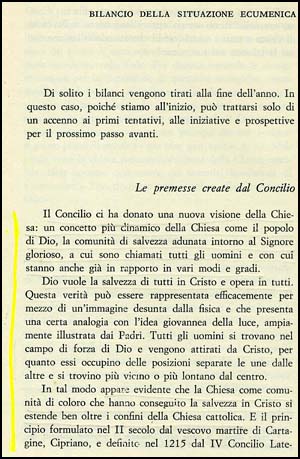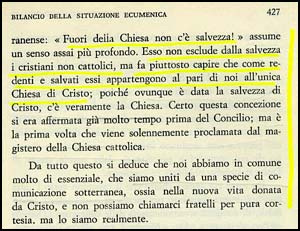In the wake of the Declaration Dominus Jesu, the Congregation for the Doctrine of the Faith issued another document about the "Church of Christ." No clear definition of what the "Church of Christ" is has been issued. Some conservatives still claim that the Church of Christ is made of Catholics only; all progressivists affirm that it also includes Protestants and Schismatics.
To elucidate the topic we bring the testimony of Card. Julius Dopfner, one of the four Moderators who directed the Council, who strongly defends the latter proposition.
Right, the cover of The Living Church Today. Below left, our translation of the Italian text highlighted in yellow.
The Council gave us a new vision of the Church: a more dynamic concept of Church seen as people of God, the community of salvation reunited around the glorious Lord, to which [community] all men are called and are already related in various ways and different degrees. ... Therefore, it appears evident that the Church as community of those who have attained salvation in Christ extends well beyond the confines of the Catholic Church.
In this way, the principle formulated in the second century by Cyprian, the Bishop-martyr of Carthage, and defined in the year 1215 by the Fourth Lateran Council - 'outside the Church there is no salvation' - takes on a much more profound meaning. It does not exclude non-Catholics Christians from salvation, but rather imparts the understanding that ... they belong along with us to the one Church of Christ. For the Church is where the salvation of Christ is truly given. Certainly this concept had already been affirmed long before the Council; but it is the first time it was solemnly proclaimed by the Magisterium of the Catholic Church.
From all this, it can be deduced that much of what is essential we share in common, that we are united by a kind of subterranean communication, that is, in the new life given by Christ. And it is not by mere courtesy that we call ourselves brothers, but because we really are.
(Julius Dopfner, La Chiesa Vivente Ogg, Bari: Paoline, 1972, pp. 426-427)
|



|
|
